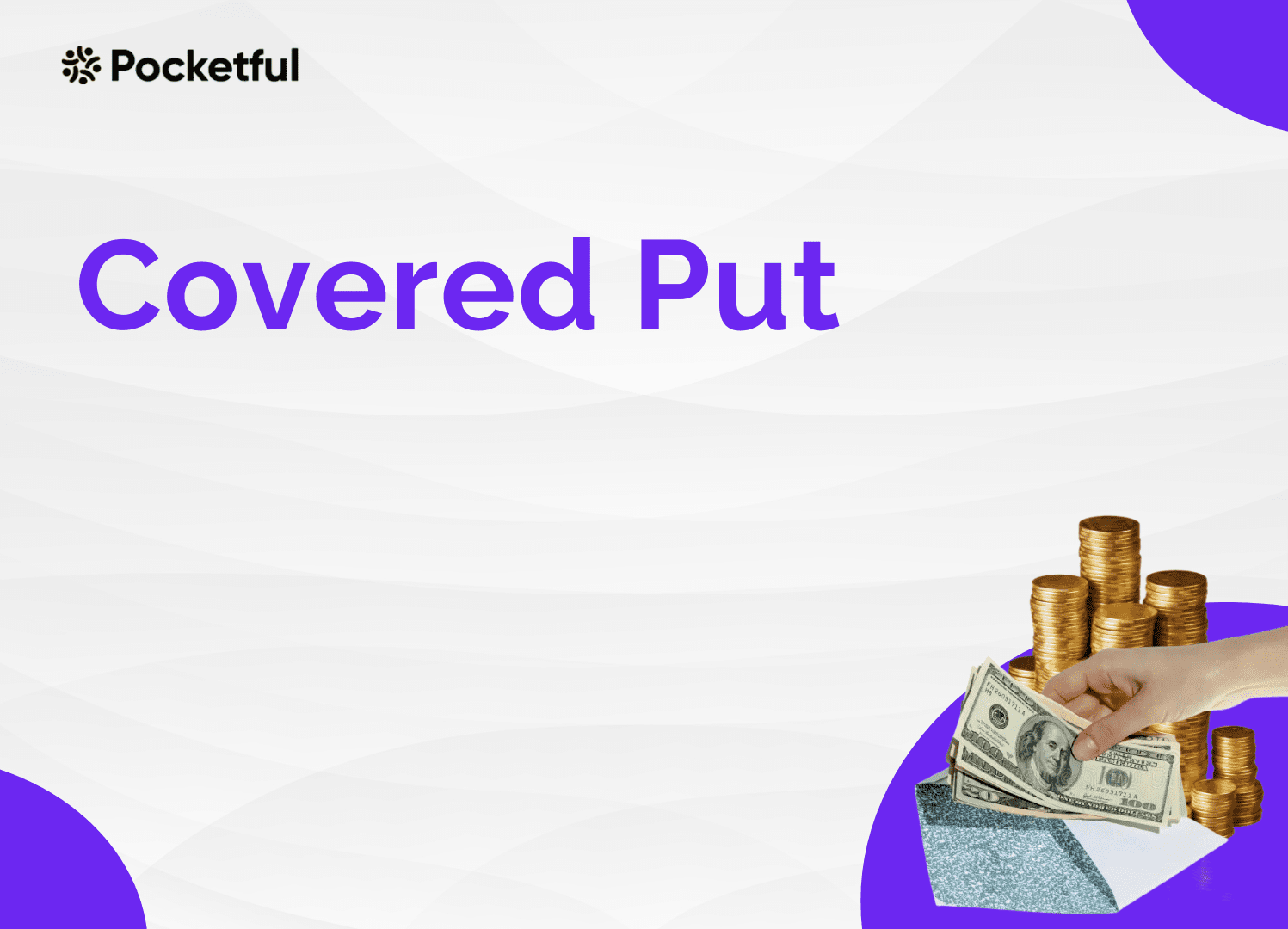| Type | Description | Contributor | Date |
|---|---|---|---|
| Post created | Pocketful Team | Jul-01-24 | |
| Add new links | Nisha | Mar-18-25 |
What is a Covered Put Strategy?

Covered Put strategy could help you earn some extra income in a range-bound market with a slightly bearish outlook; let’s find out how.
As an investor, you use this technique when you think the price of a stock or index will stay in a narrow range, fall slightly, or volatility will fall. The Covered Put approach is used to benefit from a neutral to bearish outlook of the markets. In the Covered Put writing strategy, investors sell a stock or short the index and also sell a put on the stock or index. In today’s blog, we will further explore its payoff scenarios with an example and its advantages and disadvantages.
What is the Covered Put Strategy?
The Covered Put is a neutral to bearish market view and expects the price of the underlying to remain in a range or go down slightly. The investor simultaneously sells a put and the stock. When the option is out-the-money, the investor keeps the premium. As the investor shorted the stock in the first place, the investor is protected from downside movements. The investor keeps the premium if the stock price does not change. In a neutral market, he can use this method to generate income. The risk is unlimited (if the security’s price increases significantly), while the reward is limited in this strategy.
The Put that is sold is usually an out-of-the-money put. Shorting a stock indicates that the investor is bearish on it, but is willing to purchase it back once the price reaches a target price. This is the price at which the investor sells the Put (Put strike price). If a put is sold, it means that if it is exercised, the stock will be purchased at the strike price.
When to use Covered Put?
The Covered Put works well when the market is moderately Bearish. Employ this strategy when you are expecting a moderate drop in the price and volatility of the underlying.
Covered Put Strategy Payoff Scenarios

Covered Put strategy has the following payoff scenarios:
Break Even Point = Sale Price of stock + Premium Received
Maximum Profit = Sale Price of stock – Strike Price + Premium Received
(The maximum profit is limited to the premiums received and downward movement until the strike price of the put. The position remains profitable unless the short position in security doesn’t exceed the premium received.)
Maximum Loss = Unlimited
(The maximum loss is Unlimited as the price of the underlying can theoretically go up to any extent.)
Example

Let’s take a simple example of a stock called Coal India trading at Rs 460 (spot price) in June. The option contracts for this stock are available at the premium of:
July 450 Put : Rs 20
Lot size : 100 shares in 1 lot
Sell 100 Shares : 100*460 = Rs 46000 Received
Sell July 450 Put : 100*20 = Rs 2000 Received
Now, let’s discuss the possible scenarios:
Scenario 1: Stock price remains unchanged at Rs 460
Buy 100 Shares : 100*460 = Rs 46000 (no profit or loss)
Short July 450 Put : Expires worthless
Net Credit was Rs 48000 initially received to take the position.
Total Profit : 48000 – 46000 = Rs 2000.
The total profit of Rs 2000 is also the maximum profit in this strategy. This is the amount you received as a premium at the time you entered the trade.
Scenario 2: Stock price goes to Rs 550
Buy 100 Shares at Rs 550, sold initially at 460 : (460*100) – (550*100) = – Rs 9000
Short July 450 Put : Expires worthless
Total Loss = – 9000 + 2000 (Premium Received) = – Rs 7000
In this scenario, Rs 9000 is the loss made from shares shorted. The net loss made in this transaction is Rs 7000.
Scenario 3: Stock price goes down to Rs 400
Buy 100 Shares at Rs 400, sold initially at Rs 460: (460*100) – (400*100) = Rs 6000
Short July 450 Put : Expires in-the-money (400-450)*100= – Rs 5000
Total Profit = 6000 – 5000 + 2000 (Premium Received) = Rs 3000
In this scenario, Rs 6000 is the profit earned from shares shorted. At the same time, we lost Rs 5000 in July 450 Put. The net profit earned is a Rs 2000 premium received at the beginning and Rs 1000 from the short position.
Read Also: What is Covered Call?
Advantages of Covered Put
- Benefits from decreasing volatility : Covered Put works best when volatility decreases.
- Time decay benefits in Covered Put : Covered Put benefits from the passage of time.
- Income-generating strategy in a sideways market : A covered put strategy is used if an investor is moderately bearish and plans to hold a short position for an extended length of time. The covered put will help generate income during the holding period.
- Use it as a hedge : It is used to hedge a short position. If an investor holds a short position, they can use a covered put strategy to limit their downside risk. By selling a put option, they can offset some of the potential losses from their short position in the security.
Disadvantages of Covered Put
- Limited Profit Potential : Covered Puts have defined maximum profits.
- Undefined Risk Strategy : In this strategy, maximum loss is unlimited.
- Require a higher margin : To short an option higher margin is required.
- Assignment risk : It exists when an investor writes an option. An early assignment occurs when a trader is forced to buy or sell stock when the short option is exercised by the long option holder. In Short put assignment the option seller must buy shares of the underlying stock at the strike price much before the time period strategy requires to become profitable.
- Expiration risk exists in a covered put strategy : A big rise in the stock price, not only near expiration, is always a threat to this strategy.
- Futures should be used for shorting as there are limitations on shorting stocks.
Conclusion
Covered Put is used when you are mildly bearish on the market. This strategy involves selling an OTM Put Option along with selling the underlying. Ideally, this strategy is well executed using stock futures due to limitation of shorting stocks by exchanges. Only intraday shorting of shares is allowed. As you are moderately bearish, you won’t mind buying back the underlying (obligation to buy under Put Option) if the price goes down to the strike price. At the same time, you will make gains on your short position on the underlying as the price goes down and also on the amount of premium received on a Put Option. When using a covered put strategy, maximum loss is unlimited as stock prices can rise significantly and maximum gains are limited. Covered Puts have pros and cons, an investor should understand every aspect of it before deciding to take a position.
Frequently Asked Questions (FAQs)
What is a Covered Put trading strategy?
Short stock + Sell OTM stock Put Options
Is Covered Put Safe?
Though it is a basic option strategy, the maximum loss is unlimited in it, so it’s not for beginners as some knowledge and experience are required in it.
Is Risk involved in this strategy?
Yes, unlimited risk is involved in this derivative strategy.
Is the Covered Put different from the Protective Put?
Yes, the Protective put strategy has a long position in stock and a long position in put to protect from any downside. An investor buys puts, so the loss is limited to just the premium, while profit is unlimited on the bullish side due to a long position in the stock.
When to write a Covered Put?
When the trader is neutral or slightly bearish in the market.
Disclaimer
The securities, funds, and strategies discussed in this blog are provided for informational purposes only. They do not represent endorsements or recommendations. Investors should conduct their own research and seek professional advice before making any investment decisions.